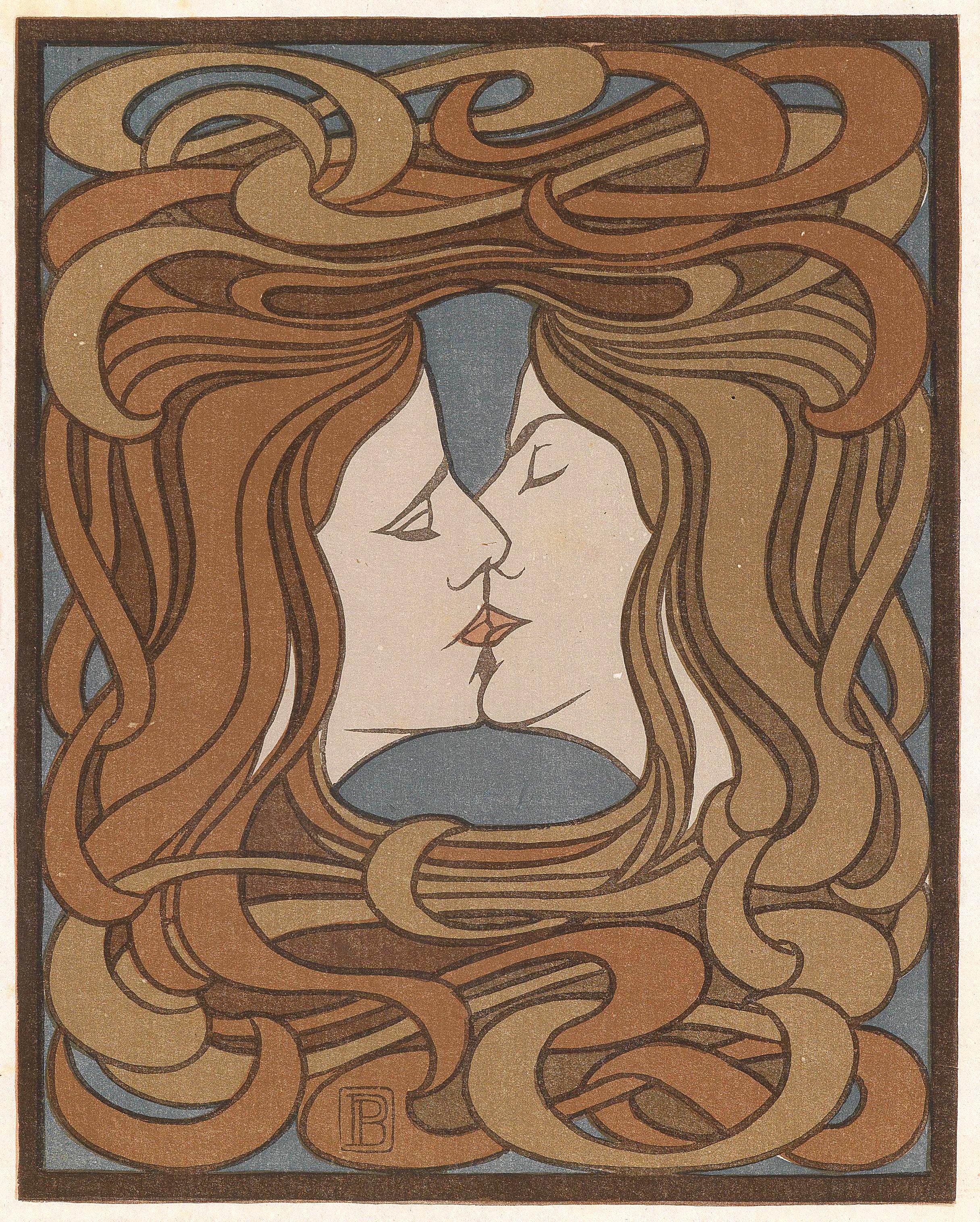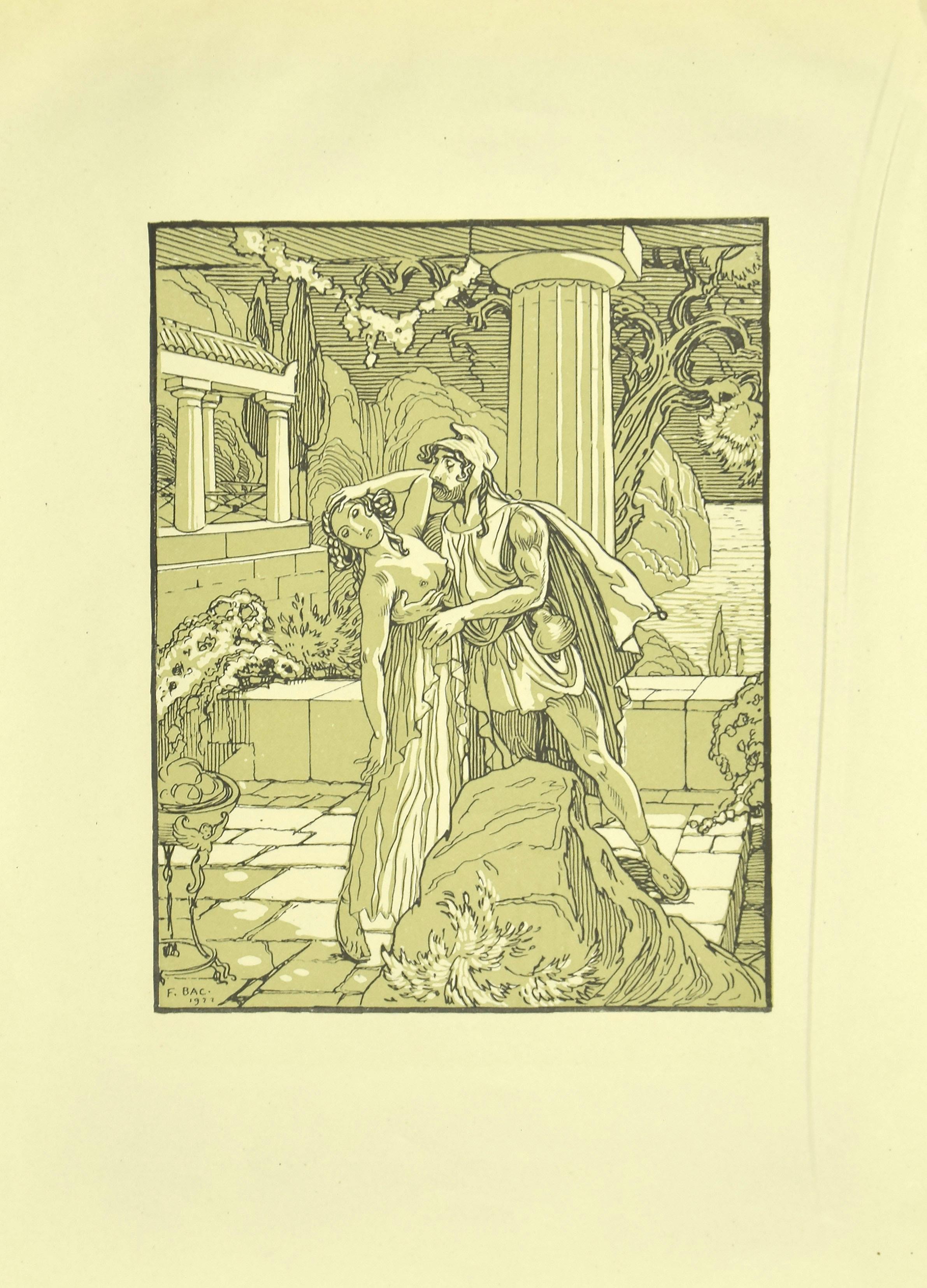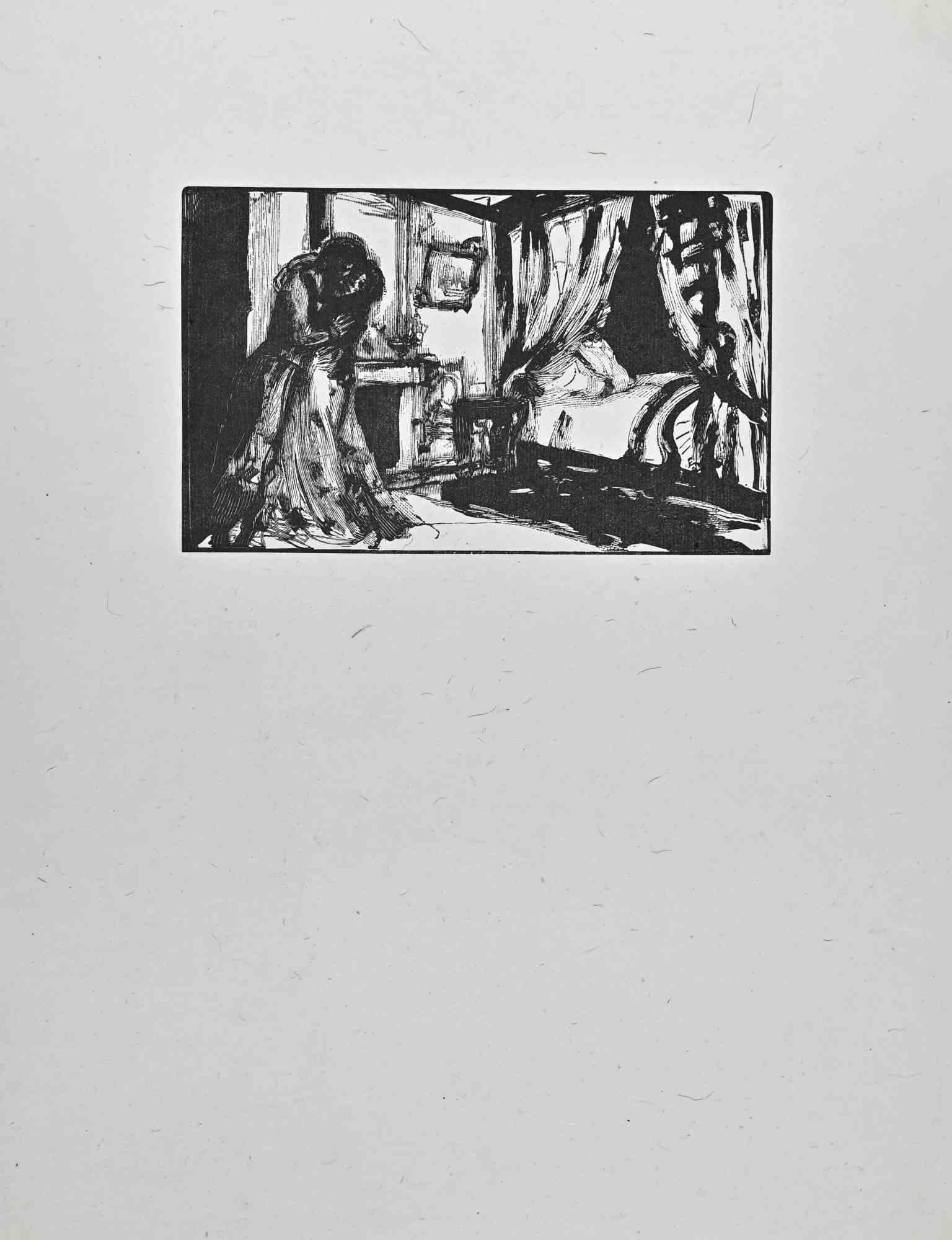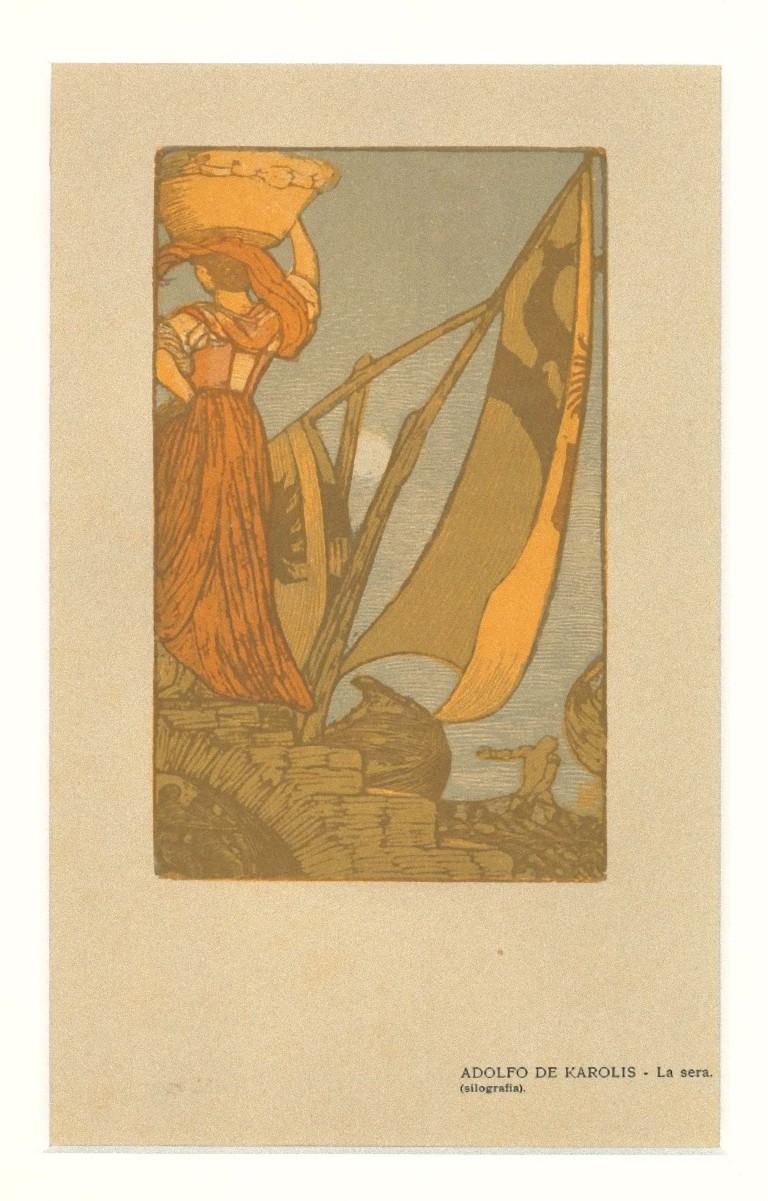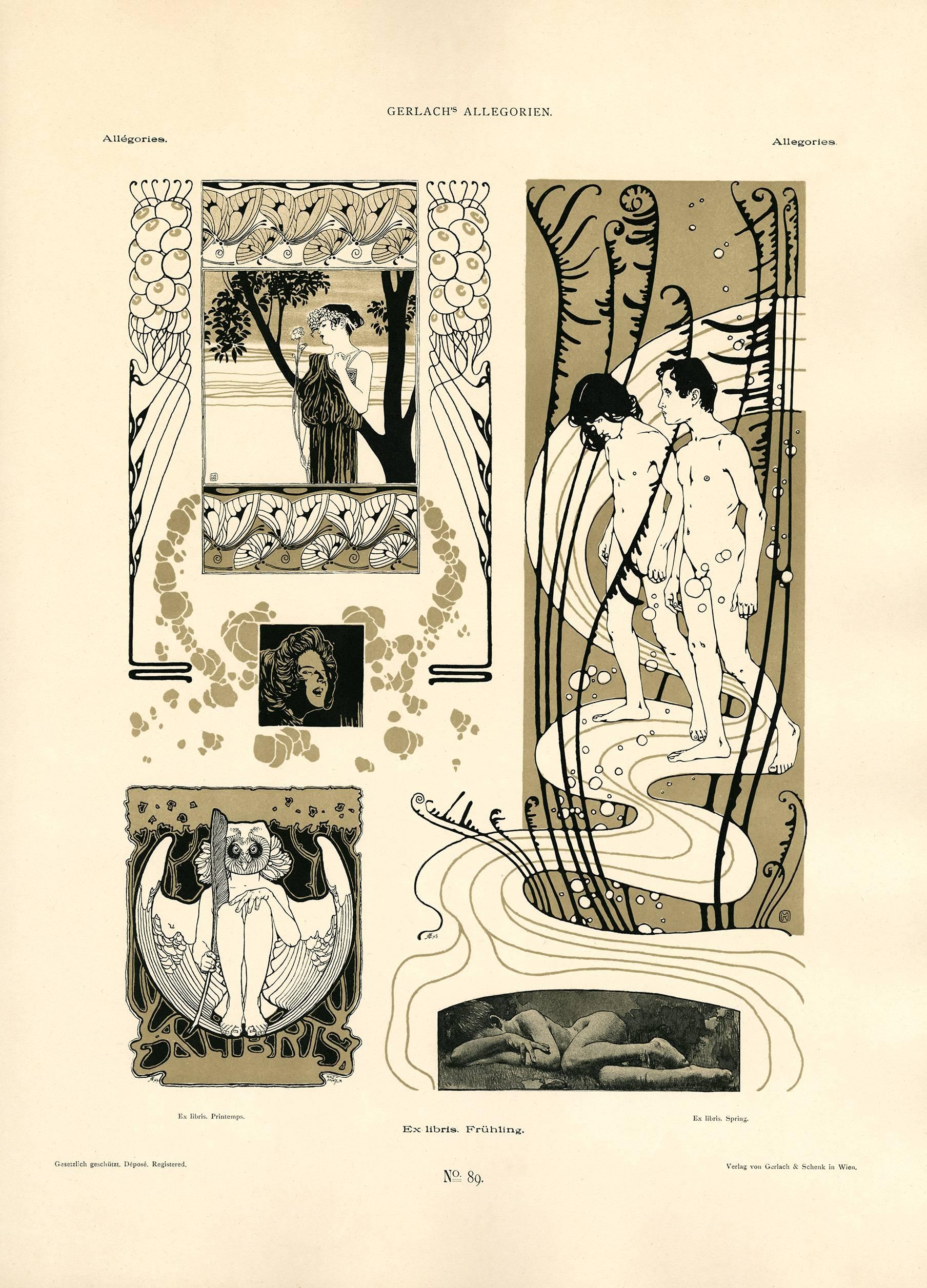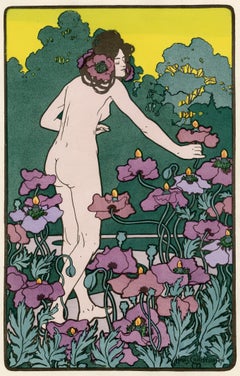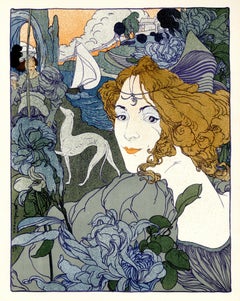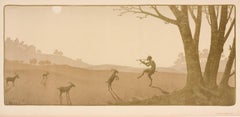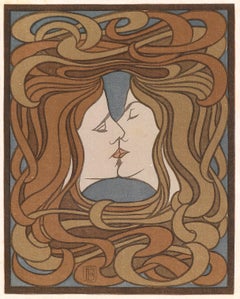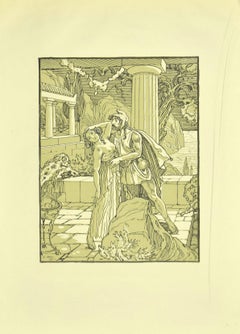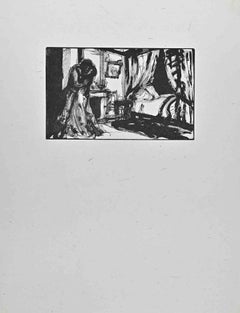Items Similar to Der Kuss The Kiss (plate facing page 116)
Want more images or videos?
Request additional images or videos from the seller
1 of 5
Peter BehrensDer Kuss The Kiss (plate facing page 116)1898
1898
$3,500
£2,665.25
€3,043.54
CA$4,917.93
A$5,395.91
CHF 2,842.31
MX$64,190.02
NOK 36,409.59
SEK 33,246.93
DKK 22,738.19
About the Item
Der Kuss The Kiss (plate facing page 116)
Color lithograph, 1898
Signed with the artist's initials in the image (see photo)
Published in Pan, Volume IV.2 (Jul-Aug-Sept 1898)
Publisher: Genossennschaft Pan GmbH, Berlin
Printer: Dr. C. Wolf & Sohn, Munich
Total edition 1213
From the deluxe edition of 75 (as here), General edition 1100
According to Iain Boyd White, "The Kiss depicts a kissing couple, their faces framed and joined by voluptuous Jugendstil curves formed of their own tresses." One of the most acclaimed prints of the Jugendstil movement and a modern masterpiece.
Reference: Rifkind Center 221
Condition: Full sheet
Colors fresh
Slight aging staining to sheet
Old hinges verso
Housed in APF frame with OP3 Acrylic and a deep bevel linen mat
- Creator:Peter Behrens (1868 - 1940, German)
- Creation Year:1898
- Dimensions:Height: 10.625 in (26.99 cm)Width: 8.5 in (21.59 cm)
- Medium:
- Movement & Style:
- Period:
- Condition:Full sheet Colors fresh Slight aging staining to sheet Old hinges verso Housed in APF frame with OP3 Acrylic and a deep bevel linen mat.
- Gallery Location:Fairlawn, OH
- Reference Number:Seller: FA117911stDibs: LU14013764232
About the Seller
5.0
Recognized Seller
These prestigious sellers are industry leaders and represent the highest echelon for item quality and design.
Gold Seller
Premium sellers maintaining a 4.3+ rating and 24-hour response times
Established in 1978
1stDibs seller since 2013
835 sales on 1stDibs
Typical response time: <1 hour
Associations
International Fine Print Dealers Association
- ShippingRetrieving quote...Shipping from: Fairlawn, OH
- Return Policy
More From This Seller
View AllL'heure de Berger (Hour of the Shepherd)
By Hans Christiansen (b.1866)
Located in Fairlawn, OH
L'heure de Berger (Hour of the Shepherd)
Color lithograph, 1898
Signed in the stone lower right
As published in L'Estampe Moderne, Paris, March, 1898
Edition: 2000 (there was also a ...
Category
1890s Art Nouveau Nude Prints
Materials
Lithograph
Gemini-The Twins
By Eugène Grasset
Located in Fairlawn, OH
Signed in the right center edge of the image
From: Les Douze Mois de 1889
As published in Vol. 9, No. 425 of Les Hommes d'Aujourd'hui.
Published by Sagot, Paris
Proof before letters...
Category
1880s Art Nouveau Prints and Multiples
Materials
Lithograph
Retour (Homecoming)
By Georges De Feure
Located in Fairlawn, OH
Retour
Color lithograph, 1897
Signed in the stone lower left edge of the image (see photo)
As published in "L'Estampe Moderne"
L'Estampe Moderne appeared each month as a portfolio of...
Category
1890s Art Nouveau Figurative Prints
Materials
Lithograph
Vision Antique
By Paul Berthon
Located in Fairlawn, OH
Vision Antique
Color lithograph, 1899
Signed in the stone upper left (see photo)
Titled in the stone lower right (see photo)
Edition: unsigned edition about 200 (per Arwas)
Published...
Category
1890s Art Nouveau Abstract Prints
Materials
Lithograph
L'Angellus
By Alfredo Müller
Located in Fairlawn, OH
L'Angellus
Etching, engraving and acquatint on Arches paper, 1902
Signed lower right by the artist (see photo)
This is a first state impression printed in a brown/black ink, one of ...
Category
Early 1900s Art Nouveau Figurative Prints
Materials
Etching
Moto-Flirt
By Georges Meunier
Located in Fairlawn, OH
Moto-Flirt
Color lithograph, c. 1902
Signed in the stone lower right (see photo)
Published by Edmund Sagot (1857-1917), Paris
Printed by Atelier Chaix, Paris
Large edition with title...
Category
Early 1900s Art Nouveau Figurative Prints
Materials
Lithograph
You May Also Like
The Kiss
By Peter Behrens
Located in Palm Beach, FL
Artist edition of 38 on Imperial Japon paper. Genossenschaft Pan GmbH, Berlin, publisher; Dr. C Wolf & Sohn, Munich.
Category
1890s Art Nouveau Figurative Prints
Materials
Woodcut
The Stolen Kiss - Original Lithograph by F. Bac - 1922
Located in Roma, IT
The Stolen Kiss is an original modern artwork realized by Ferdinand Bac (1859 - 1952) in 1922.
Original Lithograph on ivory paper.
Signed and dated on plate on the lower left corne...
Category
1920s Art Nouveau Figurative Prints
Materials
Lithograph
The Romantic Kiss - Woodcut rint by Paul Baudier - 1930s
Located in Roma, IT
The Romantic Kiss is a woodcut print on ivory-colored paper realized by Paul Baudier (1881-1962) in the 1930s.
Good conditions.
Paul Baudier, (born October 18, 1881 in Paris and di...
Category
1930s Modern Figurative Prints
Materials
Woodcut
Family : Mother and Father Kissing a Baby - Original lithograph - 1898
By Victor Prouve
Located in Paris, IDF
Victor PROUVE
Family : Mother and Father Kissing a Baby, 1898
Original lithograph (Champenois workshop)
Printed signature in the plate
On vellum, 40 x 31 cm (c. 16 x 12 in)
INFORMA...
Category
1890s Art Nouveau Figurative Prints
Materials
Lithograph
La Sera - Woodcut on Paper by Adolfo De Karolis - 1906
Located in Roma, IT
La Sera is an original woodcut on ivory-colored paper realized by Adolfo De Karolis.
The state of preservation is very good.
Signed and titled, Ad...
Category
Early 1900s Art Nouveau Figurative Prints
Materials
Lithograph
Gerlach's Allegorien Plate #89: "Bookplate Spring" Lithograph
By Koloman Moser
Located in Palm Beach, FL
Koloman Moser
(1868 –1918), AUSTRIAN
Instead of applying his flair and art education solely to painting, Koloman Moser embodied the idea of Gesamt Kunstwerk (all-embracing art work) by designing architecture, furniture, jewelry, graphics, and tapestries meant to coordinate every detail of an environment. His work transcended the imitative decorative arts of earlier eras and helped to define Modernism for generations to come. Moser achieved a remarkable balance between intellectual structure (often geometric) and hedonistic luxury.
Collaborating with Gustav Klimt and Josef Hoffmann, the artist was an editor and active contributor to Ver Sacrum, (Sacred Spring), the journal of the Viennese Secession that was so prized for its aesthetics and high quality production that it was considered a work of art. The magazine featured drawings and designs in the Jugendstil style (Youth) along with literary contributions from distinguished writers from across Europe. It quickly disseminated both the spirit and the style of the Secession.
In 1903 Moser and Hoffmann founded and led the Wiener Werkstatte (Viennese Workshop) a collective of artisans that produced elegant decorative arts items, not as industrial prototypes but for the purpose of sale to the public. The plan, as idealistic then as now, was to elevate the lives of consumers by means of beautiful and useful interior surroundings.
Moser’s influence has endured throughout the century. His design sensibility is evident from the mid-century modern furniture of the 1950s and ‘60s to the psychedelic rock posters...
Category
1890s Vienna Secession Figurative Prints
Materials
Lithograph
More Ways To Browse
Peter Kiss
Francisco Mora
Francoise Gilot Signed
George Andreas
Gilot Signed
Henri de Toulouse-Lautrec On Sale
Henri Matisse Danseuse
Henry De Groux
Hogarth Etching
Iwo Jima
Jacques Jacob
Jean De Paleologue
Jim Dine Dorian
John Buckland Wright
Journal Des Demoiselles
Kathe Kollwitz Etchings
Kees van Dongen On Sale
Keith Haring Eye
